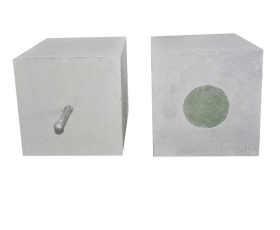- 17
- Oct
Causes of damage to ladle air bricks
Causes of damage to ladle air bricks

(Picture) DW series slit type سانس وbleڻ واري اينٽ
Breathable bricks are high-end functional refractory materials and do not work continuously during the entire ladle turnover cycle, so different physical and chemical corrosion will occur at different times. Judging from the 17 years of R&D, production, sales and use practices of Luoyang Ke Innovative Materials Co., Ltd., the damage of breathable bricks can be divided into the following types:
1 Oxygen burning effect
After the ladle is tapped to the next time before the steel is connected, the ladle will be hot repaired in the hot repair zone. At this time, it is necessary to burn the working surface with oxygen to clean the remaining steel and slag on the working surface. Oxygen lance blowing is beneficial to the normal use of ventilating bricks. This measure ensures the cleanliness of the ventilating brick working surface and the unblocked gas passage, so that the ladle turnover can be carried out smoothly. However, it is difficult to accurately grasp the thickness of the residual steel and slag on the working surface of the ventilating block in the hot repair area. Therefore, after the residue is removed, the ventilating brick will be burnt incorrectly or excessively. When the bottom of the package is in poor condition Or the operator in the hot repair area may make a mistake when it is judged. The temperature of the oxygen lance reaches above 2000 ℃, and the high temperature airflow is very lethal to the ventilating brick. The melting loss in these few minutes is often higher than the erosion loss in normal use. 2~3 times. To
2 The role of thermal stress
The refractory materials of the ventilating brick working surface, especially the refractory materials around the air outlet of the ventilating brick, will produce a large temperature gradient due to the direct contact with the high-temperature molten steel and the influence of the high-temperature molten steel and the continuous outflow of cold airflow. Due to repeated use, the ventilating brick receives a great effect of rapid cooling and heating, especially near the air outlet, the thermal stress is greater, and it is prone to ring cracks and breakage.
3 Mechanical wear
During the tapping process, the high-speed and strong scouring of the molten steel on the bottom of the ladle will also accelerate the erosion of the air-permeable bricks. The research on the corrosion of ventilated bricks through hydraulic model test found that when the low-speed airflow is injected into the liquid-phase molten pool, the airflow hits back and hits the front of the ventilating brick, giving a certain impact to the refractory around the vent of the ventilating brick. . When the gas flow rate is further increased, the reverse pulse frequency is reduced, but the reverse impact strength is further increased; in addition, when the argon is blown into the normal spray state, the strong bubbles form a gas jet, and the jet strengthens the stirring at the bottom of the ladle. The liquid phase movement at the bottom of the ladle is intensified, and the two-phase plume causes the ventilating brick to be subjected to strong shear and impact stress. When the air-permeable brick is higher than the seat brick, the shearing and scouring of this kind of plume are especially obvious. The part higher than the seat brick is generally washed away after one use. Therefore, when the air-permeable brick is newly replaced, this situation is often It is easy to happen; in addition, if the valve is closed quickly after refining, the reverse impact of molten steel will also accelerate the damage of the ventilating brick.
4 Chemical attack
The working surface of the ventilated brick has a long contact time with the slag and molten steel, and the molten slag continuously infiltrates and penetrates into the brick during the entire package service. The oxides MnO, MgO, SiO2, FeO, Fe2O3, etc. in molten steel and steel slag react with breathable bricks to form low-melting substances and metamorphic layers. Some low-melting substances will be washed away. If the temperature difference between hot and cold is too large, the performance of the metamorphic layer and the ventilating brick body will change greatly, causing the ventilating brick to break and peel off under the action of thermal stress, which seriously affects production efficiency and may even cause accidents.
